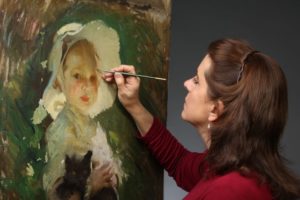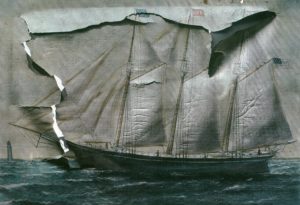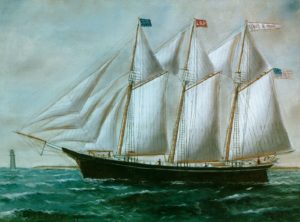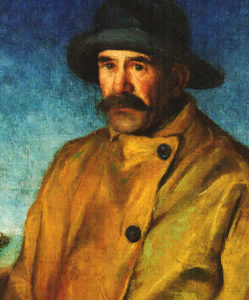
WELLFLEET — The picture, painted in about 1898 by S.F.M. Badger for Capt. Lewis R. Paine, was a classic Americana image of Paine’s ship plowing a translucent sea in full-blown sail, a lighthouse stiff in the background.
It was also a restorer’s nightmare.
A descendant of Wellfleet’s Paine family had brought it to Debra Dickinson’s studio in South Wellfleet on a veritable stretcher and she took it in with the professional and personal concern that has made her one of the most sought-after restoration artists on the Cape and beyond.
The painting’s story was ignoble and far too common.
Shrouded in a blanket and interred in an attic, a cat, having made a bed of it, had torn a Freddy Krueger gash across its face.
On top of that wound, a film of gray fireplace soot lay over brown aging varnish, and the elegant sails and soft sky of the picture had crumpled like the surface of a barn door.


Dickinson has been saving the lives of Cape Cod art for over 30 years. She has learned the science of restoration from some of the world’s leading conservationists, and she brings to her vocation a passionate tenderness as well as a subtle ability to reach for and match an artist’s original intent.
Dickinson says that when she begins to study a work of art she perceives it in overlapping layers of substance and history. Knowing when and where the work was done tells her what period paints to match and what backing material to repair. Familiarity with an artist’s work may allow her to recognize idiosyncratic ways of mixing and laying down paint.
Sea captains moving between Cape Cod and the Far East often commissioned their ships’ portraits in China. Had this been one of them it would have been painted on a silk-like fabric that would respond differently than canvas to restoration procedures.
Dickinson used enzyme gels to remove smoke stains gently from the surface of the varnish, and solvents to remove the old varnish itself.
“First I had to steam the canvas to soften it,” she explains. “Otherwise it never would have flexed enough to come together. Then I had to realign every thread of the tear using a jeweler’s loupe. It was hard work, picking at it for over a year.”
Dickinson often uses ultraviolet and infrared light and X-rays to detect where underlying problems lie. She may “rake” a painting’s surface with a beam of light to turn up hard-to-notice dents, cuts, and missing paint. It can reveal buried signatures, changes in the design by the artist, or even an entire image painted beneath another.
Often she has to hold a painting together with a temporary “facing tissue” and impregnate flaking paint with a conservation-grade adhesive known as Beva that rebinds it to its original surface.

Without conservation efforts most artwork crumbles back into dust. Water, cigarette smoke, mold, folding, bad restoration, and family feuds all take their toll on a picture’s ability to survive.
This defies the illusion that “Life is brief but Art is long.” People invest in art with the belief that it’s more structurally solid than, say, the stock market.
But consider this: nearly every old and not-so-old artwork in a museum is no longer in its original state, having been re-supported, re-varnished, repainted, and re-established perhaps countless times over many years.
A running joke among conservation professionals is that 99 percent of the Mona Lisa is not her original paint.
The stillest work of art on your wall has been, like a horror film creature, in a constant state of creeping movement since the day it was made.
Although we’re not comfortable knowing the art we treasure is falling apart, there is a strong counter-philosophy that respects the authenticity of time’s patina and time’s loss, a philosophy to which Dickinson is sensitive. She carefully weighs the consequences of entropy versus rescue.

When she was finally done re-anchoring the old paint and reconnecting the weave, the captain’s painting was so clean people asked if she had repainted the sails and sky.
“You only want to retouch where the paint is missing,” she says. In this case, she managed to retouch no more than two percent of the original oils, she says.
Not all paintings are that lucky. And not all paintings can be saved.
Dickinson recalls a badly flaking mural Alexander Calder had done on a friend’s wall in Eastham. “Calder took his rope belt off, dunked it in various cans of house paint, and painted underwater sea creatures on an old plaster wall,” she says. But it was impossible to save the old paint and Calder’s fun has probably since drifted to the floor.
Dickinson has restored more than 1,600 Cape Cod paintings for families, collectors, historical societies, and museums. She was recently appointed to the Pilgrim Monument and Provincetown Museum collections committee.
Well honored or forgotten, artworks respond to Cape Cod air and the darkening that comes with time. Their delicate cleaning and repair delights Debra Dickinson because “they literally come to life in my hands.”
There is something intangible she’s come to see as unique to Cape artwork. “What keeps coming out is the effect of the land and the sea,” she says. “You can’t get away from it.”
Editor’s note: Due to a reporting error, an earlier version of this article referred to Dickinson’s use of wax resin adhesive, a restoration method that was used in the past but is no longer employed by qualified professionals.



